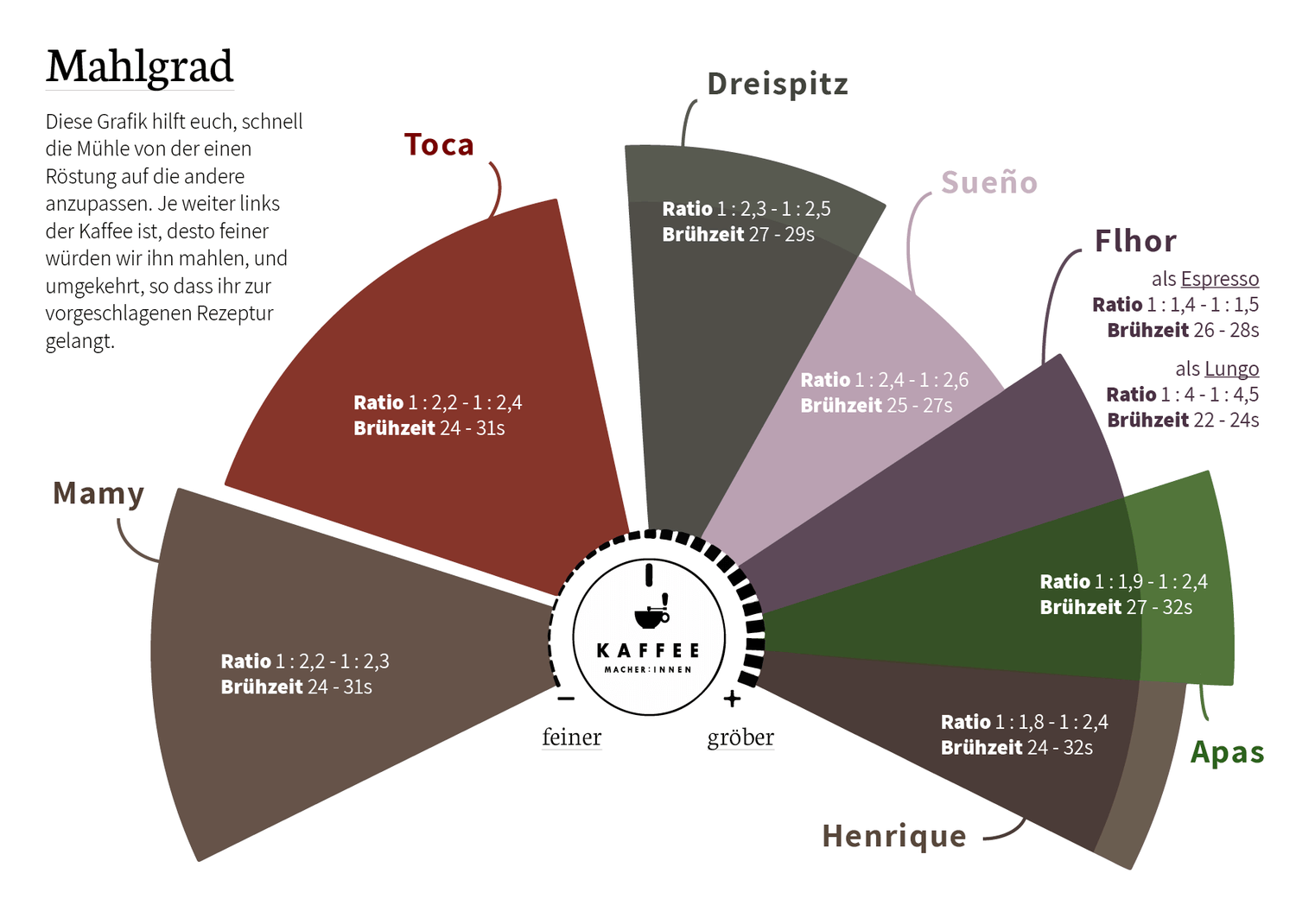This espresso cheat sheet is designed to help you adjust our espressos quickly and easily. It also shows you how to switch from one type of coffee to another to quickly achieve great results and save coffee.
Preparation times for our espresso roasts / sweet spot vs. sweet range
We often talk about a sweet spot in espresso extraction, a point where the espresso tastes better to us. We purchase green coffee beans and roast them to such an extent that this sweet spot is more of a sweet range , a point where the coffee excels.
General remarks:
- The darker a coffee, the shorter the extraction time on the extraction systems, which quickly increase from 0 to 8-9 bar.
- The lighter a coffee, the longer we usually extract
- For espresso machines with pressure profiling , such as lever machines, the San Remo YOU , or the Decent, we also extract darker roasts for longer. These pressure profiles can be individually adjusted to the coffee, resulting in longer extraction times than with an immediate increase in pressure.
- For more information on how we prepare specialty espressos, watch the video here

The optimal grind for our espresso roasts
Grind settings cannot be copied. Not between different grinders, not even between two identical models from the same manufacturer. The grinding disc settings, the dead space , and the particle distribution make espresso grinders, in particular, a unique subject.
However, we can give general estimates of the grind size if we establish a reference framework. The far left on our scale is very fine ( Mamy ), the right next to it ( Toca ) is fine, and the slightly coarser Apas is slightly coarser. We recommend grinding Henrique even coarser than Apas.
Especially if you know our coffees or use them as a reference, you can now put them into perspective and the faster setting on the grinder should work even easier.
Changing the mill, made easy
The graphic above should make it even easier for you to quickly adjust the grind size when switching between our coffees. We grind the coffees on the left finer, and the coffees on the right coarser. The gap between the individual coffees in the graphic is the same as we would set it on the grinder.
Example 1: Switch from Toca to Henrique
- you have a Toca in the mill and want to switch to Henrique
- we would not grind a little coarser (then you would have the Dreispitz), but considerably coarser
Example 2: Switching from Apas to Mamy
- The Apas is in the mill and you want to switch to the Mamy
- You are guided by the graphic and would grind much finer
Coffee properties and grinder settings
With the help of the following information, you'll be able to adjust your coffee brewing process more quickly. These are general assessments that we've compiled from our experience.

Drink ratios / brew ratio / matter of taste
The ratio of ground coffee used to the amount of coffee brewed in the cup is called the brew ratio —although there's a significant difference. For filter coffee , the brew ratio is defined as the ratio between the amount of roasted coffee and the amount of water added to the ground coffee. For espresso, however, we're talking about the ratio between the amount of ground coffee used and the brewed amount in grams in the cup.
The days of ultra-strong espressos are increasingly over. A good ten years ago, it was easy to find high-strength, low-extraction double espressos in specialty cafes. Too often, these drinks were unbalanced.
By reducing the ratio, we increase the extraction of the coffee grounds and support the balance of the espresso. By increasing the flow of water through the grounds, we also increase the extraction rate, which can add sweetness to the coffee.
Basically, when choosing the right brewing ratio, we are making a compromise between texture, balance of sweetness and acidity, and the intensity of aroma.
Just as tastes vary, so do the brewing ratios chosen.
We have summarized our preferences here:
- We like lighter roasts in a larger brewing ratio, e.g. 1:2.4 and higher
- We prefer darker roasts in a smaller brewing ratio, e.g. 1:2.2 and higher
- We particularly like Robusta roasts like Mamy in a ratio of 1:2
- Particularly very floral coffees convince us with longer extractions such as 1:2.6 and more



























